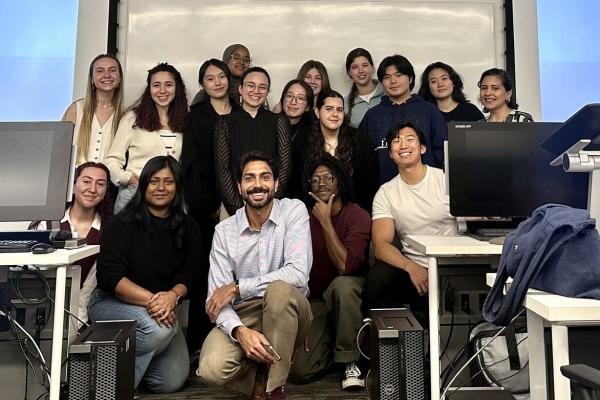In early 2025, Partners In Health Canada partnered with 2nd year students in the George Brown School of Design, Digital Experience Design program. The goal? To tackle real-world nonprofit communication challenges and explore how digital experiences can connect more people to our mission of delivering high-quality health care to those who need it most.
The initiative was led by Professor Arjit Singh, who reached out to us through email at pihcanada@pih.org, in December looking for an industry partner for an experiential learning project. When we met, we shared what we were trying to solve: improving our digital engagement, connecting with our community, and telling our story more clearly online.
The timing was perfect. The opportunity to collaborate with George Brown became a pilot for how academic partnerships can advance social impact design and deliver value for both students and nonprofit partners.
Inside the Purpose-Driven Semester
The semester ran from January to April 2025, with three student teams, each made up of four to five students. In the first class, we introduced PIH Canada’s mission and global health equity work, an opportunity to connect with students who, for the most part, hadn’t heard of us before.
Over the next four months, students explored how we could improve our digital storytelling, inspire action, and deepen connections with our supporters. We supported them with:
- A kickoff session introducing PIH Canada’s goals, audiences, and challenges
- An early brainstorm and feedback session to help guide their research
- A shared Slack channel for questions and real-time collaboration
- Access to real campaign materials, brand guidelines, and campaign data
- Ongoing mentorship from our communications team
- In-person attendance at their final presentations to offer feedback and thanks
To show our appreciation, students were given PIH Canada water bottles, tote bags and a collection of thank-you gifts, a small gesture for the care and effort they poured into their work.
What the Students Created
Each team brought something unique to the table. Ideas that were empathetic, strategic, and rooted in real-world user needs. They weren’t just designing websites or tools. They were asking: how do we move people? How do we build trust? How do we tell a story that inspires action?
During their final presentations, students walked us through their concepts, showing everything from wireframes and user journeys to campaign mockups and messaging strategy:
- A Global Impact Map: An interactive, zoomable experience spotlighting PIH’s presence around the world, making it easy to see where and how we work.
- A Fitness Fundraising App: A gamified platform that turns personal fitness goals, like running or walking, into global health fundraising challenges.
- Digital Kiosks for Public Spaces: Concepts for installations in high-traffic hubs like Union Station to introduce new audiences to PIH Canada’s work.
Each concept offered a unique take but shared a common theme: that digital design can be a tool for justice. In fact, one of the projects, a global impact map, has already informed our work to bring more interactivity and storytelling to PIH Canada’s website, including our new global impact map.
“It was a pleasure to work with Partners in Health Canada to explore creative ways to solve for increased digital engagement and donations. While the real social good work happens on the ground – around the world – where PIHC delivers care, having an opportunity to contribute to the cause in our own ways was really fulfilling.
Being a part of a digital program in a rapidly evolving technology landscape can be really challenging – I’m glad that through this partnership, the students got to experience and learn the Service Design aspect of this field. Impactful partnerships like this help the students empathize with who they are designing for and lets them see that while the deliverable might be a technological solution, it’s often only a small part of an otherwise bigger result.”
— Professor Arjit Singh
Why Partnerships Like This Matter
For the students, this collaboration opened the door to purpose-driven design. An experience far different from traditional corporate briefs.
Many left seeing new possibilities for their future: that you don’t need to work for a major brand to make an impact, you can build a career in social good.
For PIH Canada, the collaboration helped us refine ideas, new perspectives, and a way to connect with young people interested in advocacy, design, and global health. It also sparked conversations that could grow into future supporters, student chapter members, or long-term partners.
These touchpoints matter. Grassroots movements don’t begin with a donation. They begin with awareness, empathy, and connection. And that starts with meeting people where they are.
“Collaborating with PIHC pushed us to think beyond aesthetics and functionality, focusing also on empathy, storytelling, and how digital experiences can inspire action. It was rewarding to create solutions that are both user-friendly and practical to implement, and the experience helped me develop skills that will benefit my future career in designing purpose-driven and impactful digital experiences. Knowing our work could help raise more awareness and support for PIHC’s missions made it even more meaningful.”
— Natasha Martin, Student
Looking Ahead: Building the Next Generation of Changemakers
This collaboration proved what’s possible when nonprofits and academic programs come together. It allowed us to contribute locally, right here in Toronto, while staying focused on our global mission.
We’re deeply grateful to Professor Singh and the entire Digital Experience Design cohort for their creativity, compassion, and commitment.
We see this as the first of many opportunities to build student partnerships in our work. If you’re a faculty member, student, or experiential learning lead interested in working with PIH Canada, whether in design, public health, or communications, we’d love to connect.



